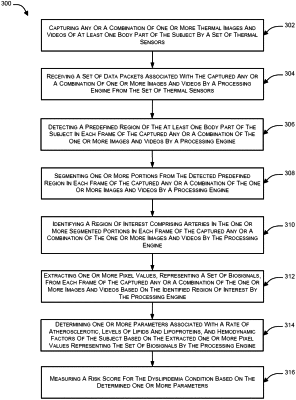| CPC A61B 5/7275 (2013.01) [A61B 5/015 (2013.01); A61B 5/02007 (2013.01); A61B 5/02028 (2013.01); A61B 5/02055 (2013.01); A61B 5/0261 (2013.01); A61B 5/14546 (2013.01); A61B 5/14552 (2013.01); A61B 5/489 (2013.01); A61B 5/7257 (2013.01); A61B 5/7267 (2013.01); G06T 7/0012 (2013.01); G06T 7/11 (2017.01); G06V 10/25 (2022.01); G06V 10/443 (2022.01); G06V 40/171 (2022.01); G06T 2207/10016 (2013.01); G06T 2207/10048 (2013.01); G06T 2207/20056 (2013.01); G06T 2207/30104 (2013.01); G06T 2207/30201 (2013.01); G06V 2201/03 (2022.01)] | 19 Claims |

|
1. A system for measuring dyslipidemia condition of a subject, the system comprising:
a set of thermal sensors for capturing any or a combination of one or more thermal images and videos of at least one body part of the subject; and
a processing engine operatively coupled to the set of thermal sensors, and comprising one or more processors coupled to a memory, the memory storing a set of instructions executable by the one or more processors to:
receive a set of data packets associated with the captured any or a combination of one or more images and videos from the set of thermal sensors;
detect a predefined region of the at least one body part of the subject in each frame of the captured any or a combination of the one or more images and videos on receipt of the set of data packets;
segment one or more portions from the detected predefined region in each frame of the captured any or a combination of the one or more images and videos;
identify a region of interest comprising one or more arteries in the one or more segmented portions in each frame of the captured any or a combination of the one or more images and videos;
extract one or more pixel values, representing a set of biosignals, from each frame of the captured any or a combination of the one or more images and videos based on the identified region of interest;
determine one or more parameters associated with a rate of atherosclerotic, levels of lipids and lipoproteins, and hemodynamic factors of the subject based on the extracted one or more pixel values representing the set of biosignals; and
measure a risk score for the dyslipidemia condition based on the determined one or more parameters.
|
|
19. A method for measuring dyslipidemia condition of a subject, the method comprising:
capturing, by a set of thermal sensors, any or a combination of one or more thermal images and videos of at least one body part of the subject;
receiving, by a processing engine, a set of data packets associated with the captured any or a combination of one or more images and videos from the set of thermal sensors operatively coupled to the processing engine;
detecting, by the processing engine, a predefined region of the at least one body part of the subject in each frame of the captured any or a combination of the one or more images and videos on receipt of the set of data packets;
segmenting, by the processing engine, one or more portions from the detected predefined region in each frame of the captured any or a combination of the one or more images and videos;
identifying, by the processing engine, a region of interest comprising arteries in the one or more segmented portions in each frame of the captured any or a combination of the one or more images and videos;
extracting, by the processing engine, one or more pixel values, representing a set of biosignals, from each frame of the captured any or a combination of the one or more images and videos based on the identified region of interest;
determining, by the processing engine, one or more parameters associated with a rate of atherosclerotic, levels of lipids and lipoproteins, and hemodynamic factors of the subject based on the extracted one or more pixel values representing the set of biosignals;
measuring, by the processing engine, a risk score for the dyslipidemia condition based on the determined one or more parameters.
|